
Curated with aloha by
Ted Mooney, P.E. RET

The authoritative public forum
for Metal Finishing 1989-2025

-----
Chrome plating and Hydrogen Embrittlement Relief
Q. Hi Everybody.
Thank you for sharing your experiences.
Is there any difference between the time needed for heat treatment of 100 micron chrome plated bar and 30 micron, for example?
Manufacturer - Tehran, Iran
May 16, 2024
⇩ Related postings, oldest first ⇩
for Shops, Specifiers, & Engineers
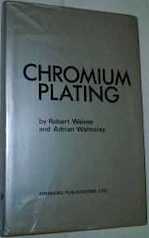
by Weiner & Walmsley (1980)
avail from eBay, AbeBooks, or Amazon
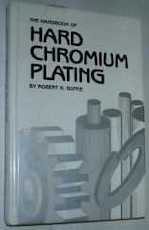
by Robert K. Guffie (1986)
avail from AbeBooks, or Amazon
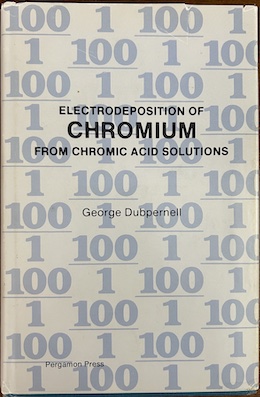
avail from eBay, AbeBooks, or Amazon
"Hard chromium plating: A Handbook of Modern Practice"
by John David Greenwood (1971)
avail from eBay

very rarely avail from Amazon
but copies are available in a few libraries)
"A Chromium Plating Bath With The Fluoride Ion"
by Alfred Perlenfein (2013)
avail from eBay, AbeBooks
(as an Amazon Associate & eBay Partner, we earn from qualifying purchases)
Q. After chrome plating, how important is it to get a part into an oven for embrittlement relief bake? If the time until baking extends too long, will the hydrogen tie up and be unable to diffuse out of the steel. Also, what time is sufficient to bake a high strength steel that has just been chrome plated? What benefit does shot peening provide during chrome plating? Does chrome plating induce a stress on the substrate during plating and how large? What causes hydrogen embrittlement?
Drake Clarke1998
A. Hydrogen Embrittlement is caused by the Hydrogen evolved during electrolysis being, to some extent, absorbed into the crystal structure of the steel at its' surface. Normally baking at 200 °C will remove the atomic Hydrogen before it has had chance to migrate and become molecular. Documented tests carried out by the Spring Research Institute in the UK have suggested that if baking is carried out within 24 hrs. of plating the Hydrogen can be removed. However it appears that many specifications request that the treatment be carried out within a much tighter timescale. I have heard evidence that suggests that this may, in some cases, be due to the desirability to ensure that the operation is carried out and not forgotten!
If the baking operation is not carried out on High Strength Steels then almost certainly it will be to late after the 24 hr. period and the Hydrogen will become molecular, being tied up with an inability to remove and provide a high degree of risk to failure.
The degree of baking of High Strength Steel would be sufficient at 24 hrs at not less than 200 °C. Consultation with UK Defence Standard DEF STAN 03-4/2 would provide more specific info (sorry don't have one to hand to quote at present).
Sorry no details on the third and second last points.
Regards
Martyn Grimesplating company - Farnham, Surrey, England
A. The present aircraft standards and AMS2406 , average 3 hours post plating bake at 190 °C. Dependent on the weight of the part. Hard Chrome does have a tendency to increase crack propagation sites in steel, due to the micro cracked structure of the coating. There is also a drop in the fatigue strength of the material which can be as much as fifty percent . Shotpeening will increase the fatigue life of some steels as much as 200 percent. Normal treatment of high strength steel parts would be: pre heat treat 190 °C for 2 hrs after grind , shotpeen 12A2 , Chromium plate , heat treat 190 °C for 3 hrs , final grind , heat treat 1 hr at 190 °C to relieve grinding stress , magnetic particle inspect. As for the embrittlement problem it is to be taken very seriously when dealing with Chrome due to the high amount of hydrogen evolved at the cathode surface in the process .
Dave Brackenridgeaerospace plating - Germiston, South Africa
Re chrome plating and hydrogen embrittlement heat treatment
Q. G'day, I have been involved in hot rodding and custom cars for about 25 years,
while restoring and building hot rods chrome plating is one of those things which must be done to get the best results.
I have recently acquired some parts for my new hot rod which are already chrome plated, and have been advised that they are not legal unless they have been heat treated for hydrogen embrittlement.
Is it possible to have the chrome plating removed, then re applied and the heat treatment applied so that the hydrogen embrittlement has then been carried out. or am I wasting my time trying to have these pieces re chrome plated.
Hobbyist - Deception Bay ,Queensland ,Australia
December 2, 2009
A. Hi, Robert. Hydrogen entrapment happens during pickling and plating, and hydrogen embrittlement occurs within a day, sometimes much less, if the parts are not baked for de-embrittlement. If the parts were hydrogen embrittled, stripping the plating and re-doing it will not help. But perhaps the baking was done properly. Is there a way to trace their origin for any certifications that may be available?
Regards,

Ted Mooney, P.E.
Striving to live Aloha
finishing.com - Pine Beach, New Jersey
for Engineers, Specifiers, and Shops

avail from eBay, AbeBooks, or Amazon
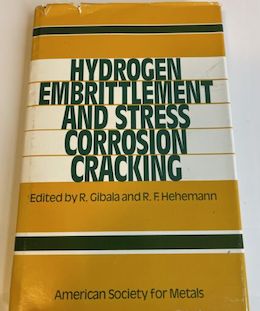
avail from eBay, AbeBooks, or Amazon
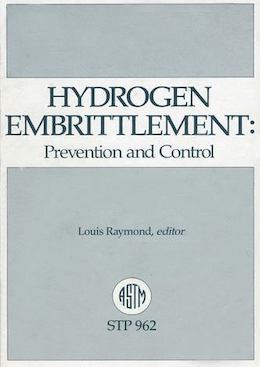
avail from eBay, AbeBooks, or Amazon
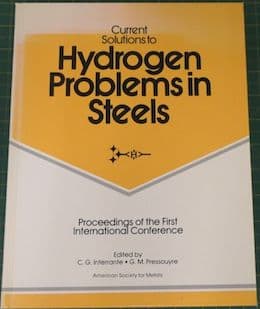
avail from Amazon
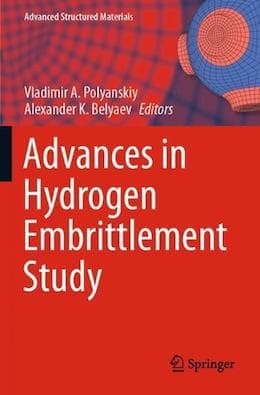
avail from eBay, AbeBooks, or Amazon
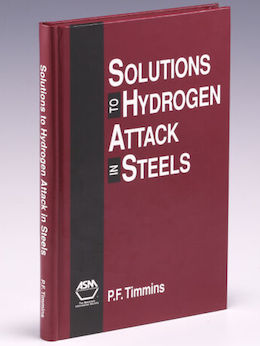
avail from eBay, AbeBooks, or Amazon
(as an Amazon Associate & eBay Partner, we earn from qualifying purchases)
Q. On the scale of salt spray test hours, what difference would a baked and non baked hard chrome plated surface would show on a metal like 4140 steel for a thickness of 25 microns ?
Jignesh Panchal- Vapi, Gujarat, India.
November 6, 2013
A. All chrome is cracked to some degree, not much to very bad. The base metal will rust thru these cracks. It will be worse with large cracks because it can set up a larger "battery" for the corrosion. Micro cracked chrome can be quite resistant to rust.
Thickness of the chrome also has a lot to do with it failing.
In answer to your question, baked or not baked has no, or at least a very tiny effect, on the salt spray test.
The bake is there to reduce the effect of hydrogen embrittlement failure.
- Navarre, Florida
Q. Thanks for the reply. I appreciate it. In addition to it, I would request you to let me know whether the baking process increases the bonding of hard chrome on 4140 steel with thickness of around 25 microns, as one of our customers insists on this. Also if a component is plated in 3 to 4 set ups, is it required to bake it after each set up?
Jignesh Panchal [returning]engineering - Vapi, India
A. Baking at 200 °C will not help adhesion enough to talk about, if at all.
I am a very strong believer in baking as soon as possible after chrome plating operation. On really hard 4140 steel we tried for 15 minutes and no more than 3 hours.
If I read your question correctly, Yes, It requires a bake after every plating operation.
- Navarre, Florida
![]() Hello Mr. Watts,
Hello Mr. Watts,
You understood my question very correctly and I am fully satisfied with your reply. It is of a great help to me. I really appreciate it.
Thank you.
- Vapi, India
A. Good outputs.
Following up on James Watts posting, a good judge on the oven dwell time of high strength steel, would be the result of your embrittlement test at the different times they dwell at 375 °F. We have yet to see a notched bar baked under 23-hrs (regardless of plating Chrome, Cad, Nickel, phosphate coating) that would pass an embrittlement test using notched bars at the 180 or higher ksi, that were baked under 23-hours. I realize that the AMS and other specs have change since these dates that increased the dwell times.
- California
September 8, 2022
Q. Why do we need hydrogen embrittlement after chrome plating?
After hydrogen embrittlement why black colour came?
Kindly send the full detail.
- Chennai, tamil nadu, India
June 17, 2014
(includes 7 papers / 34 pages on electroplating)

on eBay or
Amazon
(affil links)
A. Hi SEETHARAMAN. Hydrogen embrittlement relief is required because when the electricity is pulling chrome ions out of solution and reducing them to metal on the cathode (workpiece), it is also electrolizing the water of solution into H+ and OH-, and drawing those hydrogen ions into the metal, where they cause brittleness.
If the parts turn black during baking, you need to use a vacuum furnace or a nitrogen or argon filled furnace to exclude oxygen from the air, or at least stainless steel bags on the parts. Good luck.
Regards,

Ted Mooney, P.E.
Striving to live Aloha
finishing.com - Pine Beach, New Jersey
Chrome plating turns yellow after hydrogen de-embrittlement
Q. Hello, does anyone knows why stainless steels after hard chrome plating and hydrogen de-embrittlement have yellow color?
Alexandru Marian- Bacau Romania
April 19, 2017
Q. We are a manufacturer of deep draw parts for motorcycle jump glass cover and we have a query in nickel chrome electroplating.
Before plating we found no issuance of CRACK by hitting and vice clamping test -- both results found Okay.
But after plating we found a crack issue.
Now we want to check on baking process; please share the baking process standards.
Temperature?
Time period?
manufacturer - Karachi , Sindh , Pakistan
April 29, 2019
A. Hi Arif. A recognized baking standard and its contents have been offered by Dave Brackenridge above. I don't know whether your parts are critical enough to require baking after each individual operation as he describes, but certainly at least before plating and after plating. What is their hardness and strength? What baking protocol do you presently practice that isn't quite working?
|
|
Folks, the idea here is not for some of the readers to be students doing all the questioning and for other readers to be the teachers doing all the answering ... rather, we are all here to gain deeper understanding from each other's experiences. |
Regards,

Ted Mooney, P.E. RET
Striving to live Aloha
finishing.com - Pine Beach, New Jersey
Q. Sir, when we require chrome plating and dehydrogenation on a part, and also require cadmium plating and dehydrogenation on the same part, can we do separately dehydrogenation after completing both chrome and cadmium or can allow to do combined -- if not allowed, then please tell me in detail. I shall be very thankful for this act of kindness
Nishat Anjum- Islamabad, Pakistan, Muslim
November 26, 2019
A. Hi Nishat. I see two things to be considered regarding your question --
First, cadmium plating is virtually always chromate conversion coated and the chromate will not survive baking -- so you must bake before chromating.
Secondly, baking must be done in a very timely fashion; depending upon the hardness of the substrate, it may have to be done essentially immediately.
Thus, while you might not rule out doing just a single bake on theoretical grounds, I think you'll probably find the logistics of doing a single bake more difficult than just doing the two bakes :-)
Regards,

Ted Mooney, P.E. RET
Striving to live Aloha
finishing.com - Pine Beach, New Jersey
Q. Why Hydrogen Embrittlement is done at constant 200 °C? If done at 250 °C or 300 °C baking what can happen?
vimal pandian - vpemployee - jiaxing - zhejiang, China
September 30, 2021
A. Hi Vimal.
Hydrogen Embrittlement is very critical for hardened high strength steel. If bake is performed at very high temperature, it may affect the properties of the base material. It is one of the reasons why many parts are baked for Hydrogen Embrittlement relief at approximately 190 °C/375 °F. Some materials are baked even at lower temperatures, for example carburized parts are baked at 135 °C/275 °F. Take a look in AMS2759/9 specification - it is a good reference.
Good luck,
- Winnipeg, Canada
A. Good answer, Leon, thank you! The only thing I would add in specific answer to Vimal, is that specifications are meant to be followed; when we follow them exactly we are helping to build a vast body of highly reliable knowledge & experience. As soon as we talk ourselves into "this particular requirement probably isn't very important", we've started shooting from the hip and are dealing in anecdotes rather than a vast body of knowledge.
Luck & Regards,

Ted Mooney, P.E. RET
Striving to live Aloha
finishing.com - Pine Beach, New Jersey
![]() Great answers to great questions!
Great answers to great questions!
- Colorado USA
February 28, 2024
Q, A, or Comment on THIS thread -or- Start a NEW Thread
